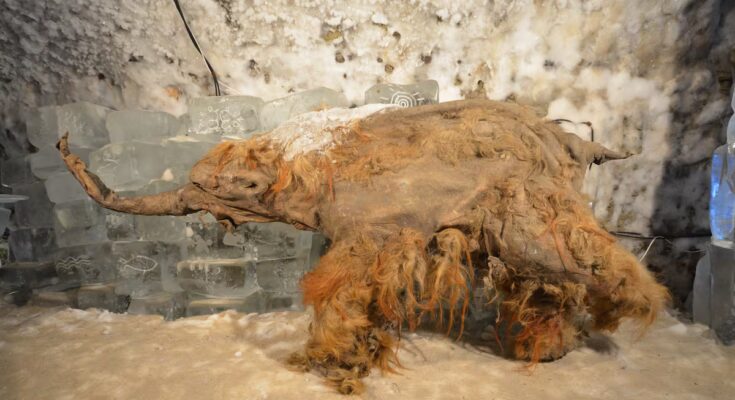Every year, when the snow melts in Siberia, groups of explorers set off in search of the mammoth. The tusks and other bones of these extinct pachyderms surface so frequently that the natives use them to prop up their tents or sell them on the black market. In the best case scenario, scientists find some of these corpses, which allows for extraordinary discoveries about the missing fauna of the Ice Age.
This Friday a team of researchers announces a discovery that seemed impossible: the rescue of the oldest RNA ever obtained. They isolated it from the body of Yuka, a dead mammoth cub molested by cave lions about 40,000 years ago. Videos recorded by the scientists themselves show the red fur-covered skin of these animals surprisingly preserved, as if they had died the day before yesterday.
Until now, it was thought that RNA, a biological molecule essential for life, was too fragile to withstand the passage of time after death. Its discovery in a mammoth takes knowledge of how the organisms of these animals functioned to a new level and could perhaps help de-extinct some of their traits, the study authors acknowledge.
“Isolating RNA allows us to know much better what their biology was like when they were alive,” summarizes Emilio Mármol, first author of the study. New molecular analysis tools allow us to recover much more biological information. Until now, DNA had been extracted from mammoths over a million years old. Sometimes the remains are so well preserved in the frozen ground that they retain their original three-dimensional structure. And just a month ago, members of this same team managed to save the DNA of not only the mammoth, but also the bacteria living in its intestinal tract.
Every cell in the body has a complete copy of the genome, made of DNA, but with this information alone it is impossible to know whether it is a skin cell, a heart cell or a brain cell. To do this, you need to know which genes are active, how much, and where, and that information is what the RNA provides.
The molecule was isolated from the animal’s muscle. This allows us to know which genes were functioning at the time of death. “We noticed that this is normal muscle tissue, but there is also RNA associated with stress,” explains Mármol, a 35-year-old paleogeneticist from Malaga who works at the University of Copenhagen, Denmark. The discovery agrees with what was hypothesized years ago by scientists who found the remains of Yuka in the Yukagir region of Russia: this animal was persecuted by predators, probably cave lions. The research was published this Friday in the scientific journal cell.
The discovery opens a new field. Until now it had barely been possible to extract RNA from ancient remains. In 2019, a canid extracted from the permafrost that lived 14,000 years ago was isolated. The work was directed by Tom Gilbert, current head of Mármol. The molecule appeared in the remains of the liver, muscles and skin, but was very deteriorated. “It was the proof of concept we needed to start working on,” recalls Mármol. On this occasion they analyzed the tissues of 10 mammoths and obtained RNA from three of them. The RNA is also not completely conserved, but in Yuka’s case these are the most complete and revealing sequences obtained to date. This study made it possible, for example, to determine that this mammoth was a young male and not a female, as was thought from the study of its DNA.
Swedish geneticist Love Dalén is another of the study’s leading authors. In recent years, his team has succeeded in extracting DNA from mammoth remains dating back more than a million years. “The results show that RNA molecules can survive much longer than previously believed,” the scientist emphasizes in a press release issued by Stockholm University. “This means that not only will we be able to study which genes were active in different extinct animals, but it would also be possible to sequence RNA viruses, such as influenza viruses or coronaviruses, preserved in Ice Age remains,” he explains.
Dalén is also a consultant for Colossal, the American company that aims to “desest” the mammoth using the Asian elephant as a model. Mármol acknowledges that the company was interested in the tools used to extract RNA from the remains. This advance could allow them to better understand mammoth biology, particularly a more complete view of molecular processes beyond DNA, he says.
But the Spanish researcher is “skeptical” about Colossal’s objectives. “I don’t believe that populations of these animals can be reintroduced and that they are sustainable over time. The environment in which these Ice Age animals lived, the mammoth steppes, no longer exists, because they are now much more temperate. Furthermore, I don’t believe that it is possible to de-extinct any species, bringing back only some internal and external characteristics,” he adds. Mármol points out that the recovery of the Tasmanian tiger, a canid that became extinct in the 1930s, is more feasible given that its habitat is still intact. In 2023, his team managed to extract and analyze RNA from 130-year-old Tasmanian tigers that had been stuffed and displayed in a museum.
Nicolás Rascován, an ancient DNA expert at the Pasteur Institute in France, points out: “It is an achievement to have recovered this type of information, because RNA is extremely unstable and usually does not last very long over time.” The scientist, who was not involved in the study, also points out that “RNA, especially messenger RNA, opens the door not only to knowing the genetic information of an organism, but also to knowing how it reads it, how it expresses it and what it can do,” he reasons. One of the things that would already be possible is to compare these processes in the mammoth and modern elephants, he explains. The work has the limitation that only muscle tissue was studied and RNA is a very specific molecule for each organ, so the results cannot be extrapolated, he concludes.


